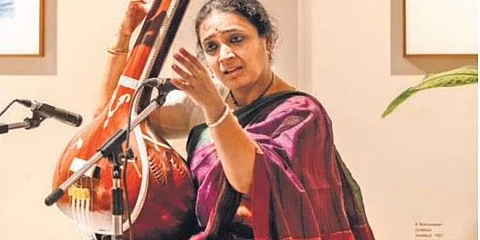

Dhrupad vocalist Pelva Naik has uncomplicated answers to complicated questions. Ask her why there are very few female Dhrupad singers in India and she states the obvious, “It’s mostly because women cannot have personal time after a certain age. If a man gets married and has children, he’ll still have the time to continue a career in music—he can practice and can spend time thinking about a raga but a woman will have to raise a child, do chores and sometimes go to work. That’s when women usually give up. Art demands a different kind of time and pace, and which women have to constantly fight for.”
While the heritage of Dhrupad, the oldest existing North Indian music form, is replete with stellar names such as Zia Fariduddin Dagar, Uday Bhawalkar, and Gundecha Brothers, most of the practitioners are male. “When I decided to take up Dhrupad, most of my contemporaries either felt I was taking a big risk, or that I wasn’t ambitious enough,” she recalls, admitting that the classical music industry, like everything else, too had come a long way since she started her musical career at 17.
With technological advances came accessibility, allowing music enthusiasts to explore and discover what they liked and did not. The 36-year-old Naik is currently in Spain and France conducting Dhrupad workshops. “The internet has done wonders. Many more young people are attending classical music concerts. Many youngsters are contacting me on social media, wishing to learn Dhrupad,” she says adding, “Dhrupad is an art form which has the ability to express emotions the way they are. Its ancient syllables and intricacies have a total connection with contemporary life. Dhrupad is timeless and universal.”
Bearing testimony to these words was a recent evening when Naik sang to an overflowing crowd comprising five-year-olds to 75-year-olds at Delhi’s Kiran Nadar Museum of Art. As Naik immersed herself in soulful renditions of her art, the audience sat mesmerised, some tapping their fingers as others listened with rapt attention.
Born in Ahmedabad, Naik comes from a family of artistes. “My grandparents and my father were singers. Painting, literature, cinema, and music have been part of my life ever since I was a child,” she remembers. Naik was preparing to apply to fine arts universities abroad, when she met the legendary Zia Fariduddin Dagar at The Valley School in Bengaluru. He took Naik under his wing. She gave up her foreign dream soon afterward.
“I was 17, and it was a chance I didn’t have to think about twice. I wanted to learn music because it puts you in touch with the truth. When you’re in your late teens, and you begin to realise what art is, it isn’t just for joy, but for something more than that. Dhrupad makes you understand your existence,” says Naik. She then moved to Mumbai to be close to her guru, who was then a guest faculty at IIT Bombay.
She remained under his tutelage till 2013 when he passed on. “I was absorbed by my guru’s personality, what he wanted to say through his music,” she says. Naik also trained under Ustad Bahauddin Dagar, a Rudraveena player and son of iconic Dhrupad player Zia Mohiuddin Dagar. Dhrupad has been a way of life for Naik, and she owes her clarity of thought to the art form. “It is very austere and minimal. Whoever sings it becomes a naked version of themselves. There’s no pretence, it’s like a container into which what you pour will be your own,” she feels.
Ancient Indian texts trace the origin of Dhrupad to Vedic hymns and mantras. It was born alongside the Bhakti movement, which explains its devotional context. Sung in temples for many years, Dhrupad was eventually patronised by the royal courts––both Mughal and Hindu, thereby enjoying supreme status in Hindustani classical music. “Dhrupad is one of the most evolved classical musical genres in India today. It carries a universal spirit that goes back to the early 11th century in the subcontinent. In present times, Dhrupad continues to live on as a unique blend of centuries of contemplation and insights nurtured by generations of masters and musicians who were deeply influenced by the diverse socio-cultural and spiritual elements of art and life in the country,” Naik says.
As pure as the musical form is, Naik is attempting to challenge the hierarchy that keeps Dhrupad at the top. “Any form of music is beautiful and exquisite. We don’t need to put classical music on a pedestal,” says the vocalist, who wants to understand more about folk and world music, which she wishes to fuse with Dhrupad. Naik’s aim is to form communities, which would travel around the world, with the objective of not just teaching Dhrupad as an art form, but also as a way to understand the world around. She recently collaborated with SangitaRasika, a Barcelona-based project that allows music aficionados to experience different classical musical traditions. This, perhaps, is another uncomplicated effort by the artiste to create awareness about an art form, which is as simple as it is divine.